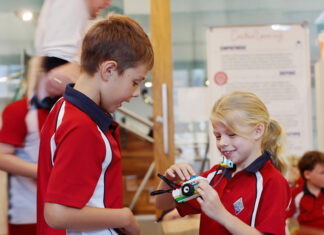Listen to the locals, was the key message that came out of last week’s two-day SharkSmart workshop, hosted by the Noosa Biosphere Reserve Foundation.
Following on from the first Noosa workshop last March, this one focused on fine-tuning messaging that combined local knowledge with scientific evidence in an attempt to increase awareness of real shark dangers, even in apparently benign waters like Noosa’s.
Led by shark expert Dr Andrew Chin from the Centre for Sustainable Tropical Fisheries and Aquaculture at James Cook University, Townsville, the workshops were built around his relatively recent experience in community consultation in shark attack hot spots like Ballina and Byron Bay on the NSW northern rivers and Cid Harbour in the Whitsundays.
“While the shark attacks at Cid Harbour were all related to diving and snorkelling and were exclusively tourists, I worked with the Byron and Ballina communities after they had a terrible run of shark incidents involving surfers, looking at the profound effects that had had on their communities, but also trying to get their perspective on what was safe and what wasn’t in local surf breaks,” Dr Chin told the workshop.
“We realised very quickly that the information that we had in the science community did not match what the local community said.
“That makes a lot of sense because scientists can’t be everywhere and animals behave differently in different places. The importance of local knowledge really came through from that experience.”
The correlation of local knowledge and scientific knowledge is part of a new approach to shark safety in Queensland. After more than 60 years of almost total reliance on outmoded shark nets and drumlines, the new plan embraces a broad palette of technologies like drones and smart drums, plus a new approach to awareness and education programs that emphasises sharks are not the enemy – when we go into the ocean we are sharing their space.
Speaking to a diverse group of marine stakeholders, ocean user groups, tourism authorities and local politicians – most of who had a love of surfing in common – Dr Chin outlined the conventional science about why and where sharks bite and then challenged it with local knowledge from Byron and Ballina, adding Noosa elements from the group as he went.
For example, science and local knowledge agree that mistaken identity is a frequent cause of shark incidents, the movement of a seal in the water and a surfer on a board being one case of similarity.
On the other hand, feeding is an uncommon cause of shark attack, backed up by the small numbers of shark fatalities caused by being eaten as opposed to dying of blood loss.
Baitfish and feeding activity rate high as risk factors in both the science and local knowledge, while the further offshore you are, it is agreed the higher the risk simply because help is further away.
But the jury is still out on the advisability of staying out of the surf pre-dawn and at dusk.
“The science on this is pretty variable,” Dr Chin said.
“Some sharks hunt by day, some by night, often the same species in different places will be different in that regard. So we look at all of these things from a scientific and a local perspective and when both agree, then we know that the conclusion must be taken very seriously.”
Other issues that Dr Chin and the SharkSmart program are examining include the traumatisation of coastal communities affected by frequent shark attacks, and the polarisation caused by people seeking solutions to attacks.
“The impacts can be severe, and not just on family and friends of victims. It can have a major impact on tourism and the local economy, which is often when you get these polarising views on how to deal with it.
“We believe the best way to deal with the trauma is to better understand the behaviour and ecology of these animals so that know more about their intentions, and can communicate safety messages accordingly.
“The best way to deal with the polarised views on dealing with the issues is to treat all of them with respect.”
Meanwhile, the Byron Bay and Ballina interactions have revealed a widespread commitment to accepting risk levels as a personal responsibility, something that is most likely replicated in Noosa’s surfing community.
In other words, based on local knowledge of their own waters and a basic grounding in the science of shark behaviour, individuals conduct their own risk assessment and then make a cost/benefit decision on whether to surf.
“This underlines the importance of locally-packaged risk messaging, but the problem is exposing tourists to that message. Not that they wouldn’t be receptive, but getting it through to them when they’ve come for a short break is difficult,” Dr Chin said.
Balancing shark safety messaging with positive tourism messages will always be a challenge, but based on five-year figures of sharks caught in drumlines and nets to 2020 made available at the SharkSmart workshop, people need to be informed rather than fearful. A total of 139 sharks were caught in drumlines and net, including 50 tiger sharks and 20 bull whalers.










